There are several reasons and scenarios that warrant the need to soundproof a home or office. Whatever the reason, they all have their root in one thing – noise. Noise according to Longman Dictionary of Contemporary English is defined as a loud, unpleasant or frightening sound. It is disruptive to hearing and it is unwanted.
Noise comes in many forms and from different sources. It can come from cars and traffic on a major road, indiscriminate playing of music by neighbors, heavy machineries, construction sites, children playing, etc. It can also come from your personal effects and properties like your car, fridge or any form of machinery you own. It can also occur at home, in your office or wherever you spend a lot of time.
There are a number of health issues that can arise from this. Some of these include stress, annoyance, anxiety, hearing loss, speech interference, and hypertension, sleep disturbance, etc. You can learn more about the health effects of noise here.
To prevent the adverse outcomes of these effects, you need to reduce your level of exposure to noise. Do you get exposed daily to any form of noise and need to know what to do about it? One way to do this is to remove the source of the noise. This is only possible if you are able to so. What happens if you cannot get rid of the source? Your only other options will then be to soundproof your space so as to prevent the noise from getting through. You do this with the use of soundproofing materials.
What is Soundproofing?
This describes a process through which one blocks, prevents or reduces sound pressure levels from a specific source from getting in or out of a particular space. There are different soundproofing techniques which include absorbing the sound, diffusing it, or reflecting it. Achieving any of these will not be possible without the use of soundproofing materials.
What are Soundproofing Materials?

Noise, as it has been established, comes from sounds. Sound starts at a source and travels through a medium, most often air, into the ears vibrating all the while. It is when it reaches the ears that it can have a negative effect. So if one cannot stop the sound from been produced, can one stop it from reaching the ears? That is exactly what soundproofing materials are for.
They do not and possibly cannot stop the sound, instead, they interrupt and prevent the transmission or at least reduces the level that gets into the human ear within a given space. You can learn more here: https://soundproofliving.com/soundproofing-materials/.
Every soundproofing material has these two important properties. These are: the sound transmission class (STC) which is the measurement of the ability of the material to block sound and the noise reduction coefficient (NRC) which measures its average absorption rate at given frequencies.
What are the Types of Soundproofing Materials Available?
There are several materials that can be used to soundproof a space. They include foam panels, acoustic mineral wool insulation, soundproof blankets, acoustic caulk sealant, soundproof drywall, acoustic fabric, floor underlay, etc.
All these are divided into different categories. These categories are discussed below.
Sound Deadening and Dampening
Because of their density and mass, these materials spread and dissipate sounds so the amplitude and impact are reduced. They work by reducing the impact of the sound vibrations coming into a space and are mostly used where there is extreme temperatures and limited space. Examples of these are sprays, mats, rolls, and paints. They also include mass loaded vinyl and floor underlayment. They are useful in stopping rattling noise and vibrations, especially in cars and machineries.
Sound Absorbing

Instead of reflecting sounds, these acoustic materials absorb and soften them and in the process improve the sound quality of a space. Examples of these are fabric which are especially useful in making soundproof curtains and blankets. Another example which is very popular is the acoustic foam. Acoustic foams can absorb, deflect, and dampen noise due to their design. They have a broad application in music and entertainment.
Sound Isolation
These have a broad application in structural engineering. They help to reduce the amount of sound transmitted from one part of a building to another so the sound is specific to a particular place or space. Examples include fiberglass and mineral wool,
Sound Decoupling
Decoupling basically means separation. It is to isolate an object from another. This is especially useful to prevent vibrations from one object to another in sound management. As an example, noise can transfer from a drywall to the framing and to the drywall on the other side of a building but by using decoupling techniques with materials in-between these three entities, sounds and vibrations will not be able to travel through. Examples are soundproof drywall, resilient channel, and soundproof windows.
Getting Started
Are you tired of having to deal with noise? Are you eager to begin to enjoy the peace and comfort of your space? Are you wondering where to start? There are several methods and materials used for soundproofing so choosing the right method and best material for you might not be easy. To take that stress off you, you can talk to soundproof experts and professionals at soundproofpros.com.
Whether you want to undertake the process by yourself and just need to buy materials or you want them to handle your whole soundproofing project, they will give you the guidance needed. These include the right materials to use for your space and the best method to employ.
Working with professionals will no doubt ensure you get the very best and at the best possible cost and time frame.




